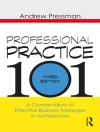The emphasis here is to explore the key issues influencing the
culture, strategies and management operations of professional
practices. The focus is upon established practices from growing
ones to large international firms in the built environment. A key
aim of the book is to promote aspects of management by function and
activities, with discipline acting as context rather than the
primary focus.
The book is structured into sections around 3 main themes:
managing the organisation; and managing specific issues that affect
operations, and a third section reflects upon management from
practitioner experience.
Section I: ‘Managing the organisation’ looks at how the history
of the firm creates both opportunities and rigidities for
developing the practice, in terms of culture and market position,
strategies and implementation, financial, marketing and HR
management.
Section II: ‘Managing specific strategic and tactical issues’
looks at how these affect approaches a discipline and operational
processes in practices. These issues compliment those covered in
Section I.
Section III: ‘Reflecting on practice’ covers experience of those
in practice and top practitioners detail how they are addressing
key issues in their practice and for their discipline. Each chapter
by a practitioner has a postscript from academic authors to make
links back to research on theory and application.
* Addresses the key issues facing practice managers
* Collects latest research from leading academics
* Offers comment on current practice from top practitioners
قائمة المحتويات
Preface.
About the authors.
Introduction (Hedley Smyth).
Section I Overview in Scope and Context of Managing the
Professional Practice.
Chapter 1 Structures, management and markets (Hedley
Smyth).
Chapter 2 Strategic management of professional practice: The
case of architecture (Graham Winch).
Chapter 3 Cross-functional coordination: Conceptual model and
its application in professional design practice (Antti
Ainamo).
Chapter 4 Challenges of growth in a medium-sized engineering
design consultancy (Andrew Edkins, James Barrett and Hedley
Smyth).
Chapter 5 Sustainability into practice: How the sustainable
development agenda has impacted on the surveying profession
(David Shiers, Tim Dixon and Miles Keeping).
Section II Managing Specific Issues in the Professional
Practice.
Chapter 6 Equipping project teams for competitions: Architecture
practices in the Italian market (Beatrice Manzoni).
Chapter 7 Client management and identification (Hedley Smyth
and Sofia Kioussi).
Chapter 8 How thin to win: FM service provision issues (Kathy
Roper).
Chapter 9 Innovation in professional service providers: UK
quantity surveying practices (Stephen Pryke).
Section III Reflections upon Practice.
Chapter 10 The make experience (Ken Shuttleworth).
Chapter 11 Squaring the circle: Delivering international
services locally (Larry Malcic).
Chapter 12 Innovation in the construction sector (Jeremy
Watson).
Chapter 13 Managing a project management division (Andrew
Mc Smythurs).
Chapter 14 Developing capacity in an emergent market (Robert
Mc Intosh).
Chapter 15 Branding professional services: Making the intangible
tangible (Kate Mc Ghee).
Chapter 16 The first 20 years (Mike Nightingale).
Chapter 17 Reflection on the redevelopment of the University of
Tokyo Hospital: The last 26 years (Shinichi Okada and Makoto
Nanbuya (translated by Junko Iwaya).
Chapter 18 Beyond the first generation (David
Stanford).
Chapter 19 Changes in UK construction professional services
firms in the late 20th century (Jim Meikle).
Conclusion (Hedley Smyth).
Acronyms.
Index.
عن المؤلف
Hedley Smyth, Senior Lecturer, School of Construction and Project Management, The Bartlett Faculty of the Built Environment, UCL.












